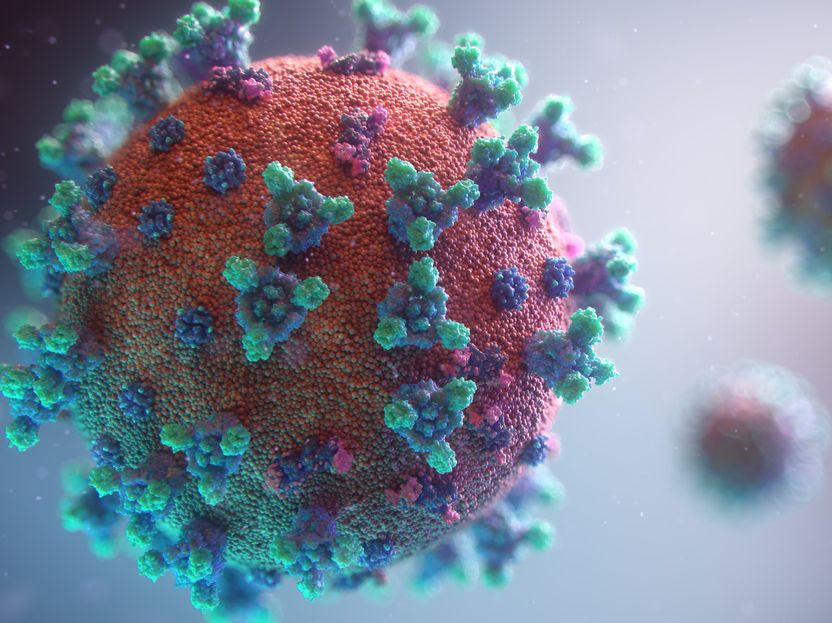Coronavirus: identification of new proteins that regulate infection
By screening the genome of different cell models, a team from Montpellier identified several hundred human genes that influence the replication of SARS-CoV-2. Some of these genes also modulate the ability to multiply seasonal coronaviruses or MERS-CoV, the coronavirus that appeared in Saudi Arabia in 2012. New studies, conducted on reconstituted respiratory mucosa in the laboratory, will now make it possible to determine which of them could constitute relevant targets for combating these infections.

Symbolic image
unsplash
Since the appearance of SARS-CoV-2, numerous studies have been conducted around the world to identify the human proteins that allow this virus to replicate in our respiratory cells, and those that prevent it from doing so. Many cellular factors have been identified through the use of the famous CRISPR molecular scissors: by allowing the activation or inhibition of each individual gene in a genome, this approach allows to question the role played by each of them in viral replication. But until now, most of these studies have not used cell models that are highly relevant from a physiological point of view. At the Montpellier Institute of Infectious Diseases, Caroline Goujon's team is the first to have conducted this work on a cell line of pulmonary origin, called Calu-3, whose behavior mimics that of human respiratory epithelium cells. The team also compared these results with those obtained in other lines.
In collaboration with the laboratory led by John Doench at the Broad Institute (USA), the Montpellier team compiled all the studies published in the scientific literature that identified genes involved in the regulation of SARS-CoV-2 replication using a CRISPR screen. The role of all the genes thus identified was then tested by the team in different cell lines of human origin. This work first allowed us to observe that the genes that interact with viral replication are not always the same depending on the nature of the cell line used. Antoine Rebendenne, first author of this collaborative study, explains: "Our observations suggest that SARS-CoV-2 is able to use different biological pathways to multiply. To know the completeness of the possible interactions between the virus and our genome, it is therefore important to work either with many different cell types or with models that are as relevant as possible from a physiological point of view, i.e. close to the cells found in the body."
Shared key proteins for replication of different pathogenic coronaviruses
The data collected from the Calu-3 cell line highlight the role of several key genes. Thus, some proteins of the adaptin family, known to regulate the addressing of other proteins in the cell, especially towards the plasma membrane, appeared to be essential for the entry of the virus into the cells. On the contrary, some proteins of the mucin family show particularly potent antiviral properties against SARS-CoV-2: expressed on the surface of epithelial cells, they act as traps that capture the viruses. " Most of the genes we identified code for proteins involved in the entry of the virus into the cell. But we have also identified genes with a later role: this is the case, for example, of ATP8B1, which codes for a protein that regulates membrane lipid composition," explains Antoine Rebendenne.
In collaboration with the Pasteur Institute of Lille, Caroline Goujon and her team were able to show that adaptins and ATP8B1 are involved in the replication of other coronaviruses, such as seasonal coronaviruses (HCoV-NL63 and -229E) or the highly pathogenic MERS-CoV. "We now want to refocus our study on the few hundred genes identified in this work, and evaluate their respective ability to influence viral replication in even more relevant models, such as respiratory epithelia grown at the interface of a liquid culture medium and outside air, obtained from patient biopsies by Professor Arnaud Bourdin's team at the Montpellier University Hospital. We also want to analyze more precisely the mechanisms on which the proviral or antiviral properties of adaptins, mucins or ATP8B1 are based. This work will help identify new therapeutic avenues against SARS-CoV-2, and perhaps against MERS-CoV or future emerging coronaviruses.
Note: This article has been translated using a computer system without human intervention. LUMITOS offers these automatic translations to present a wider range of current news. Since this article has been translated with automatic translation, it is possible that it contains errors in vocabulary, syntax or grammar. The original article in French can be found here.





















































